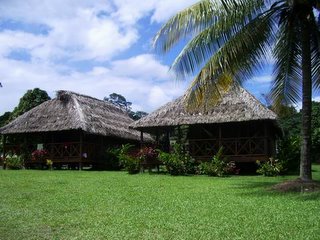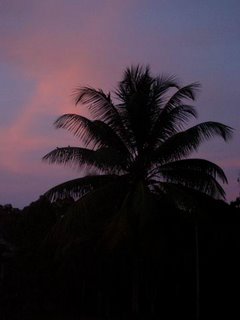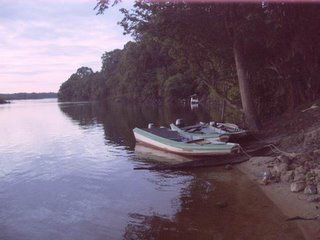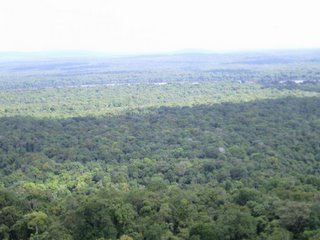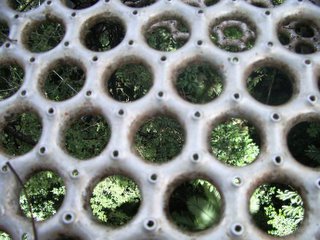Brief update on what is going on in my life….
It has been only three weeks since I came back to Guyana, and to be honest it feels like it’s been forever. Time seems to go very slowly around this time. I am counting down the weeks to the day when I go home (Canada). It makes it even worse that I have not been home (Japan) for two years, and I am getting a real urge to go.
The first few months went really quickly, since I had to concentrate on getting used to the new environment and work. Now, I know pretty much everything what to expect, so it feels much longer.
My work is quite slow, but I learn to be patient with it. It happens when it happens. This is the policy I had to adopt to keep sane.
The social life is great. Still learning the Sign Language and a bit of Spanish, couple of weekend trips already planned ahead.
I am beginning to think about my next step, which means another round of job-hunting. “When do I ever stop looking for work??” I ask myself. On a same note, if you know any interesting employment opportunities, please let me know!
私の近況はと言うと...。
ガイアナへ戻ってきてから3週間経ったが、正直に言うとまだたったの3週間?という気がする。最近になって時間の過ぎるのが遅く感じられる。帰れる(カナダへ)日まで指折り週を数えているのが実情。実家(日本)に2年も帰っていないので余計に帰りたい気がする。
最初の2,3ヶ月は時の経つのが早く感じられた。それは新しい環境や仕事に慣れようと一生懸命だったからだろう。でも今は大体のことは慣れてしまったので、1週間が長く感じられる。
仕事のペースは遅いが、忍耐力がないとやっていけないことを最近になってやっと分かった。プロジェクトでもなんでも始まるときに始まるということ。そう構えていないとストレスが溜まるので精神衛生上良くない。
プライベートは充実している。今でも手話とスペイン語を勉強していて、週末の旅行も2つほど計画中。
最近になって次のステップについて考え始めた。もちろんまた就職活動ということ!!一体いつになったら私は仕事探しを止められるの?とつい思ってしまうけど。求人情報をお持ちの方はご一報を!
About my life of working and living internationally. Bilingual postings in English/ Japanese on my daily life, work, travel and more.
dimanche, janvier 29, 2006
dimanche, janvier 22, 2006
Creolese /ガイアナ語彙集
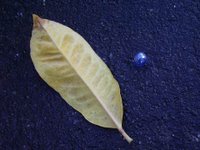
English is the official language of Guyana. However, what people speak is called Creolese. It is a mixture of English, Dutch, French and Spanish reflecting their colonial history. It has been influenced by Afro-Guyanese who were brought in as slaves and Indo-Guyanese as indentured laborers to work in the plantations after the abolition. When Guyanese talk among themselves, I still have hard time keeping up with the conversation.
They also have funny usages of some of familiar English words that surprised me, and I would like to introduce a few.
Take it or use it: This is often heard in a restaurant during lunch time. It means “take out or for here.” Guyanese seem to say “use” a lot instead of “eat.”
Walk with…: Example, “You have to walk with your lunch tomorrow.” No matter what transportation you use, bicycle, minibus or even plane, you “walk” with it. This simply means “bring it with you”
Study: Example “Are you studying home?” When I was first asked “what are you studying?” I politely answered “ I am not a student any more, though I studied Social Anthropology and International Development.” Off course the reaction was a puzzled face. The person meant “what are you thinking about?”
Watch me: This means come see me.
The other funny thing is everyone pronounces “aks” to say “ask.” I still don’t know why that is. When people say things like “me no have” and “ask he to open it”, it seems so wrong, especially for me who studied English as second language. However, language always changes with time and place, so this is part of culture.
Guyana was colonized by England for a long time, so their English is more British than America. I am used to Canadian English, which is close to American English. It didn’t feel quite right to say trousers instead of pants and torch for flashlight. But, now I am accustomed to it, and I sometimes catch myself using these words unconsciously. I borrowed a few novels from VSO library where British books dominate, and I got to learn some not very polite British slang words, too (!)
ガイアナの公用語は英語だが一般に話されているのはクレオリーズと呼ばれている。これはガイアナの植民地だった歴史を反映し英語、オランダ語、仏語、スペイン語の混じった言葉である。その経過に奴隷だったアフリカ系ガイアナ人や奴隷制度廃止後にプランテーションの使用人として来たインド人の文化の影響もあるようだ。私は今でもガイアナ人同士で話している会話になかなか付いていけない時がある。
一般的な英語の単語の使い方が変わっていて面白いものをいくつか紹介したいと思う。
Take it or use it:昼間のレストランでよく聞かれること。これはテイクアウトかその場で食べるかという意味。ガイアナ人はEat の代わりにUseをよく使用する。
Walk with…:例、You have to walk with your lunch tomorrow.”
どんな交通手段、自転車ミニバスを使ってもたとえ飛行機で移動しても”Walk” これはただ単に持参するということ。
Study: 例 “Are you studying home?”
初めて “what are you studying?” と聞かれた時は、丁寧に「私はもう学生ではありません。でも社会人類学と国際開発学を勉強しました。」と答えると困惑した顔をされた。なぜならこれは「何を考えているの?」という意味だったので。
Watch me: 「ちょっとこっちに来て」という意味合いで使われているよう。
あと可笑しいのがガイアナ人は皆”Ask”とアクスと発音すること。理由は未だに不明。Me no have とか tell he to open it のように英語を外国語として勉強してきた者にはどう見ても文法的に間違っているように思われるが、時と地域によって変遷するのが言語なのでこれもガイアナ文化の一部だろう。
ガイアナはイギリスの植民地時代が長かったので英語はアメリカ英語よりイギリス英語が使われている。アメリカ英語に近いカナダ英語に慣れた私にはpants の代わりにtrousers と言ったりflashlight(懐中電灯のこと)とは言わずにtorchと言うのは最初抵抗があったけど、今は慣れてしまい気が付くと知らずに使っていることも。イギリスの本が多いVSOの図書コーナーで何冊か借りて読んだ小説のおかげで英国イングリッシュのあんまり品の良くない俗語も勉強(?)することができた。
mardi, janvier 17, 2006
Iwokrama 写真集
lundi, janvier 16, 2006
Problems facing Guyana/ ガイアナ社会問題
I haven’t touched so much on social issue in Guyana, so I would like to write a bit about it. There is one Guyanese joke that goes:
The last person who is leaving Guyana, please turn off the light.
When I heard it, honestly I couldn’t help laughing. This is making fun of the mass out migration to US, UK, Canada and other Caribbean countries where the living standard is much higher. The estimate says that about the same number of people as the current population of Guyana (765,283 ) are living overseas. This means the half the people are somewhere else. Any Guyanese people you meet have family members living abroad. Even the people who are currently living here either already have plans to immigrate elsewhere or hope to get out. Apparently, in Canada, many Guyanese live in Scarborough Ontario. Whenever I tell people that I am from Canada, they ask “Scarborough? Scarborough?”
This so-called “brain drain” has a serious consequence, as educated and skilled workers abandon the country. There is a severe luck of human resources. Moreover, Guyana is one of the most heavily indebted countries. The public sector is curtailed down because of the structural adjustment policy. Due to the inflation, the cost of living is high, taking the average salary into account. The official unemployment rate is supposedly only 9%, but this is much under-estimated. The rent and utility are extremely expensive. The normal rent of an apartment is the equivalent of the average monthly salary. As a result, houses are jam-packed with extended families. For example, a couple cannot get their own place for a financial reason, so they have no choice but to live with their parents. As reminiscence of the socialist/ communist regime in the past, the education and the health care are free of charge, but this does not mean that they are properly operated.
This situation is the main reason of the migration, and I cannot blame the people who want to leave. Well, I too immigrated to Canada from Japan for better opportunities and so on. This “getting out of sinking ship” mentality is a vicious circle. It is a generalization, but people are not taking an ownership to their own country to build the nation, and it is almost expected that the country cannot achieve any development.
Much of the development work does focus on capacity building like my own work. However, it is a real challenge.
今まであまりガイアナの社会問題等には触れていなかったので、少し書いてみたいと思う。ガイアナのジョークで
ガイアナを最後に出る人、電気を消していって下さい。
というのがある。最初に聞いた時は悪いが笑ってしまった。どんな意味があるかと言うとガイアナは国を離れてイギリス、アメリカ、カナダまたは生活水準の高い他のカリブ諸国に移住する人が多いということ。現在ガイアナに在住する人口(76万人程)とほぼ同じだけのガイアナ人が海外で生活しているらしい。ガイアナ人は誰でも大抵家族の何人かは海外にいることが多い。現在ガイアナに居住している人でも皆機会があれば移住したいまたはもう移住の計画があるというのが珍しくない。カナダではトロント近郊のスカボロ市にいるガイアナ人が多いということで、私がカナダから来たと告げると“スカボロ?スカボロ?”とよく聞かれる。
この所謂ブレインドレインと言われる人口流出は深刻な問題である。国を本来支えていくはずの高等教育を受けた労働力、技能や知識をどんどん失ってしまうので、国を作り上げる人材が不足している。
ガイアナは世界銀行の最も負債の多い国の一つに入っており、カリブ海の中でも一番貧しい国。IMFのストラクチャルアジャストメントポリシーで政府セクターも縮小されてしまっている。インフラのせいで物価はガイアナ人の平均収入から見るとかなり高いし家賃も非常に高く、一人の給料1ヶ月分にあたる金額であり光熱費も高い。これが理由で小さい家に大家族が住んでいる。結婚しても夫婦の新しい家を持つことが経済的に難しいからだ。公式に発表されている失業率は9パーセントにしか過ぎないが、実際はもっと高いと推測されている。教育と医療は無料だがシステムが整っているとは到底言いがたい。
こういった理由から海外へ移住する人が多いので移住者を非難することはできない。私自身も仕事etcでカナダの永住権をとった“くち”なので。沈んでいく船から早く脱出しなければと考える人が多いガイアナ人のメンタリティが悪循環を引き起こしている。国に残って国家再建のために努力しようと思う人が少ないのなら国の発展と開発が進まないは当然の結果とも思われる。もちろん政治構造や民族間の不調和など他にも理由はあるが。
ガイアナの政府やNGOのキャパシティビルディング(能力開発)を中心に据えた開発プロジェクトも多いが(私の仕事もそう)容易ではない。
The last person who is leaving Guyana, please turn off the light.
When I heard it, honestly I couldn’t help laughing. This is making fun of the mass out migration to US, UK, Canada and other Caribbean countries where the living standard is much higher. The estimate says that about the same number of people as the current population of Guyana (765,283 ) are living overseas. This means the half the people are somewhere else. Any Guyanese people you meet have family members living abroad. Even the people who are currently living here either already have plans to immigrate elsewhere or hope to get out. Apparently, in Canada, many Guyanese live in Scarborough Ontario. Whenever I tell people that I am from Canada, they ask “Scarborough? Scarborough?”
This so-called “brain drain” has a serious consequence, as educated and skilled workers abandon the country. There is a severe luck of human resources. Moreover, Guyana is one of the most heavily indebted countries. The public sector is curtailed down because of the structural adjustment policy. Due to the inflation, the cost of living is high, taking the average salary into account. The official unemployment rate is supposedly only 9%, but this is much under-estimated. The rent and utility are extremely expensive. The normal rent of an apartment is the equivalent of the average monthly salary. As a result, houses are jam-packed with extended families. For example, a couple cannot get their own place for a financial reason, so they have no choice but to live with their parents. As reminiscence of the socialist/ communist regime in the past, the education and the health care are free of charge, but this does not mean that they are properly operated.
This situation is the main reason of the migration, and I cannot blame the people who want to leave. Well, I too immigrated to Canada from Japan for better opportunities and so on. This “getting out of sinking ship” mentality is a vicious circle. It is a generalization, but people are not taking an ownership to their own country to build the nation, and it is almost expected that the country cannot achieve any development.
Much of the development work does focus on capacity building like my own work. However, it is a real challenge.
今まであまりガイアナの社会問題等には触れていなかったので、少し書いてみたいと思う。ガイアナのジョークで
ガイアナを最後に出る人、電気を消していって下さい。
というのがある。最初に聞いた時は悪いが笑ってしまった。どんな意味があるかと言うとガイアナは国を離れてイギリス、アメリカ、カナダまたは生活水準の高い他のカリブ諸国に移住する人が多いということ。現在ガイアナに在住する人口(76万人程)とほぼ同じだけのガイアナ人が海外で生活しているらしい。ガイアナ人は誰でも大抵家族の何人かは海外にいることが多い。現在ガイアナに居住している人でも皆機会があれば移住したいまたはもう移住の計画があるというのが珍しくない。カナダではトロント近郊のスカボロ市にいるガイアナ人が多いということで、私がカナダから来たと告げると“スカボロ?スカボロ?”とよく聞かれる。
この所謂ブレインドレインと言われる人口流出は深刻な問題である。国を本来支えていくはずの高等教育を受けた労働力、技能や知識をどんどん失ってしまうので、国を作り上げる人材が不足している。
ガイアナは世界銀行の最も負債の多い国の一つに入っており、カリブ海の中でも一番貧しい国。IMFのストラクチャルアジャストメントポリシーで政府セクターも縮小されてしまっている。インフラのせいで物価はガイアナ人の平均収入から見るとかなり高いし家賃も非常に高く、一人の給料1ヶ月分にあたる金額であり光熱費も高い。これが理由で小さい家に大家族が住んでいる。結婚しても夫婦の新しい家を持つことが経済的に難しいからだ。公式に発表されている失業率は9パーセントにしか過ぎないが、実際はもっと高いと推測されている。教育と医療は無料だがシステムが整っているとは到底言いがたい。
こういった理由から海外へ移住する人が多いので移住者を非難することはできない。私自身も仕事etcでカナダの永住権をとった“くち”なので。沈んでいく船から早く脱出しなければと考える人が多いガイアナ人のメンタリティが悪循環を引き起こしている。国に残って国家再建のために努力しようと思う人が少ないのなら国の発展と開発が進まないは当然の結果とも思われる。もちろん政治構造や民族間の不調和など他にも理由はあるが。
ガイアナの政府やNGOのキャパシティビルディング(能力開発)を中心に据えた開発プロジェクトも多いが(私の仕事もそう)容易ではない。
dimanche, janvier 15, 2006
Iwokrama 2
In evenings, we had fun drinking, chatting and playing games. We had a variety of games, such as Uno, Wizard, Domino, and Scrabble. I was so proud to beat native speakers for Scrabble game. (It was just a sheer luck…though)
On the Christmas Eve, we exchanged the secret Santa gift. It was my first time to participate in the secret Santa, so it was a nice experience. As you probably know, you draw a name and you buy a gift for that person, but you are not supposed to tell anyone who you are buying it for. You know who you are buying it for, but do not know who is buying gift for you. I was SS for Boldi, and I bought some drinking-related items with a hand-made card. He seemed to like them, but he was probably already too drunk to think. He poured some rum right away to the shot glass I gave him.
Sarah was my SS. She made a stoking-shaped box out of cardboards, and stuffed it with gifts and candies. Since it was my first time to do this, I had an extensive consultation with Sarah, without knowing she was my SS. You can have a theme or be funny and creative with your gift.
Other activities include visit to a nearby Amerindian village, early morning and nocturnal boat rides. We saw a wild monkey, a nasty palm-size tarantella and a caiman (small alligator). This caiman is named Mr. Shanker. Iwokrama people used to feed him when he was a baby, so he still hangs in the area.
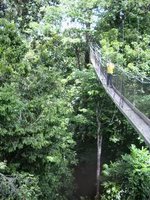
The highlight of the trip was a canopy walk. This is 30 meters off the ground and attached to living trees. It was designed in a way not to regulate the growth of trees, so it is adjustable. I am scared of heights, and I was a bit nervous, but was amazing to go through the forest on a such height.
On the last day, we took a boat ride to see the island where turtles lay eggs. We saw some eggs buried in the sand. On the way back we stopped in the middle of the big river. Some areas were shallow and made small islands of sand. The water was warm and was gorgeous. Because it was such an open area, we had nowhere to go hide and change. Us, girls took turn to hold a bath towel, so that we can all change.
Iwokrama is run by the principle of community based ecotourism. This is a system where local people, particularly the Amerindian villagers can benefit from the profit in the tourism industry. I am not sure about the researchers, but people like guides and cooks rotate, and this enables them to also pursue more traditional subsistence such as hunting and agriculture. For example, one group of employees work for three weeks, and another comes to take over to work for three weeks. This way cash/ salary can be distributed among more people. The resort itself is a small scale and can coexist with the eco system. From development perspective, this is an ideal system.
My friends were worried about feeling home sick during our stay. Even before the Christmas, people are starting to feel down, missing their usual Christmas time to spend time with their family. I guess this is an advantage to be Japanese, because Christmans doesn't mean much to me, so I was fine. Despite their worries, we all had a great time at Iwokrama.
夜は夜でお酒を飲んだり話したりゲームをしたりで盛り沢山で楽しんだ。皆ウノやウィザード(大富豪に似ているカードゲーム)ドミノやスクラブル(英語の言葉合わせのボードゲーム)などを旅行に持って来ていた。英語のネイティブスピーカーを打ち負かしてスクラブルに勝った時は嬉しかった。(単に運が良かっただけなのだが)
クリスマスイブは秘密サンタのプレゼント交換をした。この秘密サンタに参加するのは初めてだったのでおもしろかった。秘密サンタとはグループ全員の名前を書いた紙の中から一人ずつ名前を引き、その人の為にプレゼントを用意するというもの。誰のプレゼントを買うかは当日まで秘密にしなくてはいけない。自分が誰のプレゼントを買うかは知っているが、誰が自分の為にプレゼントを買うのかは分からないということ。私はボルディの秘密サンタで酒飲みの彼にはガイアナのショットグラスなど“アルコール”にまつわる物と手作りのカードをプレゼント。彼は喜んでいたけど、もうその時点でかなり酔っ払っていたのでは?嬉しそうに早速洗いもせずにラム酒を注いで飲んでいた。
イギリス人のサラが私の秘密サンタだった。彼女はダンボールで靴下の形の箱を作り、そこにお菓子やプレゼントをぎっしり詰めてくれた。実は私は初めてこの秘密サンタに参加するので要領が分からず、彼女が私のサンタとは露知らずサラに色々と相談していた。これは予算の上限も決まっているので、テーマを決めたり面白可笑しくしたりとクリエイティブなプレゼントをあげるのが理想的らしい。
他のアクティビティは近隣の先住民の村を訪ねたり早朝と夜のボート乗りなど。手のひらほどの大きさの蜘蛛や木に登っていた野生の猿、ケイマンと呼ばれるワニの一種も見ることができた。このケイマンはシャンカーという名前で、小さい頃にイオクラマの従業員が餌をあげていたので今でもしょっしゅう付近に“出入り”しているらしい。
この旅行の一番の目玉はキャノピィウォーク。地上から30メートルの高さに据え付けられて細い橋のようなもので森の一角に作られている。これは生きた木に取り付けられているので、木の生長を妨げないように調節できるように設計されたということ。私は高いところは苦手だけど熱帯雨林をこの高さから見られるのはまたとない経験だった。
最終日は亀が産卵する島へボートで行った。そこでは砂の中に埋められた亀の卵を見ることができた。帰りに、川の真ん中が干上がって島のようになっているところがありそこで休憩した。水は温かく天気も良く最高だった。水着に着替えようにも影一つない場所だったので、女の子はみんな代わる代わるバスタオルでカーテンを作って着替えた。
このイオクラマリゾートは地域型エコツーリズムに則って経営されている。観光業の収益が地域とくに先住民の村に還元されるシステム。リサーチセンターで勤務する人は分からないが、食事を作る人やガイドなどの従業員はシフト制で先住民の本来の生活(狩猟や農業など)と両立できるようにしている。例えば3週間働いた後はまた違うグループが3週間働くという風にみんなが給料(現金収入)を得られるようにしているのである。リゾートも大規模なものではなく森林と共存するように経営されている。開発の観点から言えば理想的なシステムである。
私以外は皆クリスマスを家族と過ごせないのでホームシックになるのじゃないかとかなり心配していた。他のVSO仲間もクリスマス前から落ち込んでいいる人が多かった。こんな時には日本人で良かったと思う。ツリーもキャロルもないクリスマスだったがのんびりと自然の中でリラックスできグループ全員ホームシックに罹ることもなく十分楽しめたで良かった。
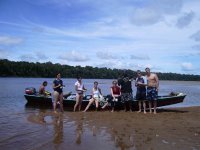
On the Christmas Eve, we exchanged the secret Santa gift. It was my first time to participate in the secret Santa, so it was a nice experience. As you probably know, you draw a name and you buy a gift for that person, but you are not supposed to tell anyone who you are buying it for. You know who you are buying it for, but do not know who is buying gift for you. I was SS for Boldi, and I bought some drinking-related items with a hand-made card. He seemed to like them, but he was probably already too drunk to think. He poured some rum right away to the shot glass I gave him.
Sarah was my SS. She made a stoking-shaped box out of cardboards, and stuffed it with gifts and candies. Since it was my first time to do this, I had an extensive consultation with Sarah, without knowing she was my SS. You can have a theme or be funny and creative with your gift.
Other activities include visit to a nearby Amerindian village, early morning and nocturnal boat rides. We saw a wild monkey, a nasty palm-size tarantella and a caiman (small alligator). This caiman is named Mr. Shanker. Iwokrama people used to feed him when he was a baby, so he still hangs in the area.

The highlight of the trip was a canopy walk. This is 30 meters off the ground and attached to living trees. It was designed in a way not to regulate the growth of trees, so it is adjustable. I am scared of heights, and I was a bit nervous, but was amazing to go through the forest on a such height.
On the last day, we took a boat ride to see the island where turtles lay eggs. We saw some eggs buried in the sand. On the way back we stopped in the middle of the big river. Some areas were shallow and made small islands of sand. The water was warm and was gorgeous. Because it was such an open area, we had nowhere to go hide and change. Us, girls took turn to hold a bath towel, so that we can all change.
Iwokrama is run by the principle of community based ecotourism. This is a system where local people, particularly the Amerindian villagers can benefit from the profit in the tourism industry. I am not sure about the researchers, but people like guides and cooks rotate, and this enables them to also pursue more traditional subsistence such as hunting and agriculture. For example, one group of employees work for three weeks, and another comes to take over to work for three weeks. This way cash/ salary can be distributed among more people. The resort itself is a small scale and can coexist with the eco system. From development perspective, this is an ideal system.
My friends were worried about feeling home sick during our stay. Even before the Christmas, people are starting to feel down, missing their usual Christmas time to spend time with their family. I guess this is an advantage to be Japanese, because Christmans doesn't mean much to me, so I was fine. Despite their worries, we all had a great time at Iwokrama.
夜は夜でお酒を飲んだり話したりゲームをしたりで盛り沢山で楽しんだ。皆ウノやウィザード(大富豪に似ているカードゲーム)ドミノやスクラブル(英語の言葉合わせのボードゲーム)などを旅行に持って来ていた。英語のネイティブスピーカーを打ち負かしてスクラブルに勝った時は嬉しかった。(単に運が良かっただけなのだが)
クリスマスイブは秘密サンタのプレゼント交換をした。この秘密サンタに参加するのは初めてだったのでおもしろかった。秘密サンタとはグループ全員の名前を書いた紙の中から一人ずつ名前を引き、その人の為にプレゼントを用意するというもの。誰のプレゼントを買うかは当日まで秘密にしなくてはいけない。自分が誰のプレゼントを買うかは知っているが、誰が自分の為にプレゼントを買うのかは分からないということ。私はボルディの秘密サンタで酒飲みの彼にはガイアナのショットグラスなど“アルコール”にまつわる物と手作りのカードをプレゼント。彼は喜んでいたけど、もうその時点でかなり酔っ払っていたのでは?嬉しそうに早速洗いもせずにラム酒を注いで飲んでいた。
イギリス人のサラが私の秘密サンタだった。彼女はダンボールで靴下の形の箱を作り、そこにお菓子やプレゼントをぎっしり詰めてくれた。実は私は初めてこの秘密サンタに参加するので要領が分からず、彼女が私のサンタとは露知らずサラに色々と相談していた。これは予算の上限も決まっているので、テーマを決めたり面白可笑しくしたりとクリエイティブなプレゼントをあげるのが理想的らしい。
他のアクティビティは近隣の先住民の村を訪ねたり早朝と夜のボート乗りなど。手のひらほどの大きさの蜘蛛や木に登っていた野生の猿、ケイマンと呼ばれるワニの一種も見ることができた。このケイマンはシャンカーという名前で、小さい頃にイオクラマの従業員が餌をあげていたので今でもしょっしゅう付近に“出入り”しているらしい。
この旅行の一番の目玉はキャノピィウォーク。地上から30メートルの高さに据え付けられて細い橋のようなもので森の一角に作られている。これは生きた木に取り付けられているので、木の生長を妨げないように調節できるように設計されたということ。私は高いところは苦手だけど熱帯雨林をこの高さから見られるのはまたとない経験だった。
最終日は亀が産卵する島へボートで行った。そこでは砂の中に埋められた亀の卵を見ることができた。帰りに、川の真ん中が干上がって島のようになっているところがありそこで休憩した。水は温かく天気も良く最高だった。水着に着替えようにも影一つない場所だったので、女の子はみんな代わる代わるバスタオルでカーテンを作って着替えた。
このイオクラマリゾートは地域型エコツーリズムに則って経営されている。観光業の収益が地域とくに先住民の村に還元されるシステム。リサーチセンターで勤務する人は分からないが、食事を作る人やガイドなどの従業員はシフト制で先住民の本来の生活(狩猟や農業など)と両立できるようにしている。例えば3週間働いた後はまた違うグループが3週間働くという風にみんなが給料(現金収入)を得られるようにしているのである。リゾートも大規模なものではなく森林と共存するように経営されている。開発の観点から言えば理想的なシステムである。
私以外は皆クリスマスを家族と過ごせないのでホームシックになるのじゃないかとかなり心配していた。他のVSO仲間もクリスマス前から落ち込んでいいる人が多かった。こんな時には日本人で良かったと思う。ツリーもキャロルもないクリスマスだったがのんびりと自然の中でリラックスできグループ全員ホームシックに罹ることもなく十分楽しめたで良かった。

samedi, janvier 14, 2006
Iwokrama 1

Eight of us (Sarah, Jo-Ann, Jillian, Maryann, Ashton, Steven, Boldi and myself) ventured out to the jungle to stay in Iwokrama resort in Rupunini (Region 9) to spend the Christmas. We took an over-night bus, which goes on one and only road leading to the area and eventually reaching to Brazil. It took us over 9 hours, as the bus broke down once and had made numerous bathroom stops (off course where no bathroom is available.) Luckily, I managed to sleep or doze most of the way there.
Iwokrama is in the middle of rainforest on the Esquibo river (one of the main rivers in Guyana.) It is a nature reserve where a research center operates. It consists of the main building of the research center, dining area, small shop etc, and several cabins for guests as well as a compound for staff members. It was a very well maintained and charming place. Perfect get-away from hectic Georgetown. Our group rented two cabins: one for four girls and another for three boys.
On the first day when we arrived, we took a morning off to nap and then went on a short excursion in a forest behind the resort. Throughout our visit, we were not very lucky on a wildlife front. We saw a limited number of animals, letting alone the jaguars . According to the locals, jaguars can be seen more on the highway. For sure they prefer the better road, don’t they?!
I am sure everyone at one point wonders how it is like to go swinging from trees to trees like Tarzan. This was a dream come true for us! On the second day when we hiked up on Turtle Mountain, there was this one area where we can swing with veins dangling from a tree. Height and swinging is not really my thing, but I didn’t want to miss out on this rare experience. The veins were so slippery, and I had hard time holding on to them. My friends took some photos of my terrified face, and it was a good laugh for them. Hiking was about three hours in total. The view from the top was magnificent. One thing that was very impressive is rain in the forest. You can see the rain coming down very high up on the trees, but it doesn’t reach you because of the dense vegetation. This view is hard to describe, but was fantastic. We were all soaking wet with our sweats, but it was worth it.
私を含めサラ、ジョアン、ジリアン、マリアン、アシュトン、スティーブン、ボルディの8人でジャングルの中にある9の地域のイオクラマリゾートでクリスマス休暇を過ごすために繰り出した。ブラジルまで続く一本道を夜行バスに揺られて行く。途中でバスが故障したのとトイレ休憩(もちろんトイレもないような場所で)が何度かあったせいもあり9時間かけて目的地へ到着した。私は運良くうとうとではあったが道中眠ることができた。
イオクラマはガイアナの大きな川のひとつであるエスクイボ川のほとり、熱帯雨林の中に位置している。ここは自然の保護区でもありリサーチセンターによって運営されている。研究所と食堂売店のあるメインの建物と宿泊客用のバンガローと従業員の住宅から構成されている。小さいが手入れが行き届いていて居心地の良いリゾートだ。ジョージタウンの喧騒を逃れるにはもってこいの場所。私たちのグループは女の子4人の為のバンガローと男3人の為と2つのバンガローを借りた。
到着した初日は朝は休憩して一眠りして、昼から宿泊エリアの後ろにある森の探検に出かけた。滞在した5日間、残念ながらジャガーはもちろんのこと野生動物には期待したほど遭遇することはなかった。地元の人によるとジャガーは高速道路で一番よく見かけられるらしい。やっぱりジャガーも通りやすい道路を好むのだろうか??
ジャングルと言うと誰でも一度は映画ターザンのように木の蔓につかまり木から木を移動するのはどんな感じだろうと思ったことがあるはず。ここで夢が叶うことになった!2日目タートル山の登山をした時、途中に丁度良い感じの蔓が木から垂れているところがあり、ガイドの人が一人ずつブランコ乗りをしても良いと言ったからだ。高いところで“ブラブラ”するのはあんまり得意ではないが、折角のチャンスを逃すのももったいないので、試すことに。実際は蔓が滑りやすくて落ちないように摑まるのが大変だった。友達が私の恐怖に震えた顔の写真を撮り、後々までもそれを話の種にして笑っていた。この登山は3時間かかった。頂上からの眺めは素晴らしかった。特に印象に残っているのが森の中の雨。雨が木々の隙間の高いところに降っているのは見えるが、木がうっそうと生い茂っているので私達の所までは届かない。言い表すのは難しいが何とも幻想的な情景だった。みんな汗でびしょ濡れになったけど、登りがいのある山だった。
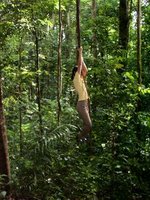
lundi, janvier 09, 2006
Back in G/T
Back from the winter wonderland to the tropics. I am amazed how my body can take 40-50 degree difference in temperature.
The first day back at the work, and I already had a blackout and the first mosquito bite. Can’t tell you how much I missed these things!! I am going to update the site about both my trip to Iwokrama and to Montreal.
The first day back at the work, and I already had a blackout and the first mosquito bite. Can’t tell you how much I missed these things!! I am going to update the site about both my trip to Iwokrama and to Montreal.
Inscription à :
Commentaires (Atom)
